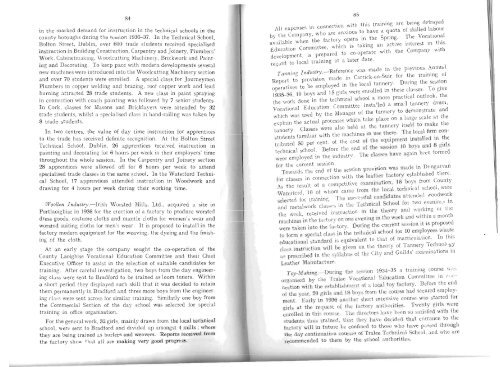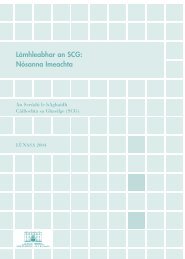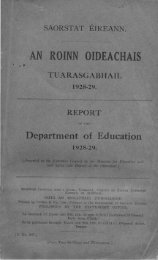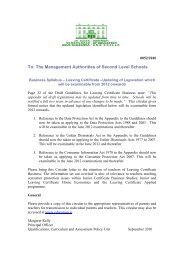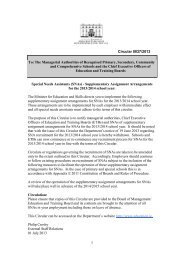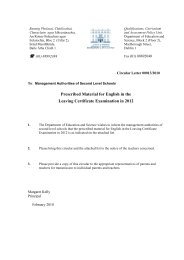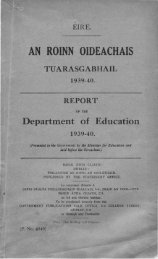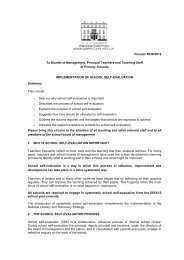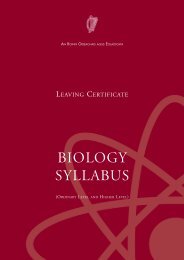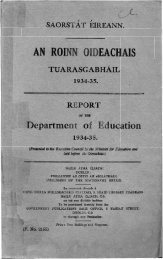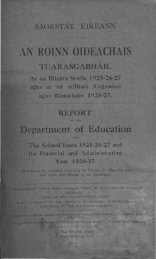82<strong>and</strong> staples. Through the co-operation <strong>of</strong> the local Technical Committee,a scheme for the training <strong>of</strong> employees has been devised which has some'novel features. It was decided that, whilst the factory was being built;machinery <strong>and</strong> equipment for the training <strong>of</strong> operatives would be installedby the company at the Technical School; this machinery willbe transferred to the factory at the end <strong>of</strong> the training course. Thefollowing plant costing approximately £2,400 has been installed:-1 Automatic Cold Heading Press, 1 Rumbler, 3 Automatic HeadTurning <strong>and</strong> Slotting Machines, 3 Automatic Threading Machines,1 Saw Sharpening Machine, 1 Tool Grinder, 1 Automatic Cut NailMachine <strong>and</strong> Power Transmission <strong>and</strong> Cutting Compound Arrangements ..For the selection <strong>of</strong> the trainees a panel was prepared by the Principal<strong>of</strong> the Limerick Technical School from students in attendanceat the day courses. The girls Were drawn from the continuation:courses in Commerce <strong>and</strong> Domestic Science, whilst the boys weredrawn from the engineering section <strong>of</strong> the trades continuation courses,The ultimate selection was made by the Works Manager <strong>of</strong> the Companyassisted by a local director <strong>and</strong> by the Principal <strong>of</strong> the SchooLThe girls were tested for accuracy <strong>and</strong> quickness in operations basedon the work they will be required to do <strong>and</strong> the boys were giverrsimilar tests <strong>and</strong> others requiring ability in mental arithmetic, manualdexterity <strong>and</strong> knowledge <strong>of</strong> tools. Eight girls <strong>and</strong> twelve boys wereselected for training. The Course is being conducted by the WorksForeman under the direct supervision <strong>of</strong> the Works Manager. Bythis method the company is assured that, when the factory is completed,it will have at its disposal a reasonable number <strong>of</strong> trainedworkers. .It is expected that the factory will begin operations in the Spring,when the boys <strong>and</strong> girls now in training will be transferred to thefactory. The training course at the Technical Sc11001will be carriedon until the end <strong>of</strong> the present session, when it is hoped that twentyfiveboys <strong>and</strong> fifteen girls will have been trained. The contact madewith the Company will be continued, <strong>and</strong> after the training is completed<strong>and</strong> the factory is in full working order, it is intended thatboth the Company <strong>and</strong> the technical school will work in close cooperationwith regard to subsequent training <strong>and</strong> the recruitment <strong>of</strong>employees.Electrical Engineering.-At the request <strong>of</strong> the Electriicity SupplyBoard, during the Session under review a short intensive day coursefor journeymen employed as Service Electricians was organised atKevin Street Technical School. The object <strong>of</strong> the course was to traintwelve journeymen electricians in the special requirements <strong>of</strong> ServiceWork on electrical appliances for domestic use, <strong>and</strong> in economics <strong>of</strong>electric lighting, cooking, heating <strong>and</strong> refrigeration. Instruction was,83given on meters, cookers, thermostats, water heating, equipment<strong>and</strong> laundry appliances, refrigeration princi ples <strong>and</strong> the general types <strong>of</strong>refrigerators, motors, wiring <strong>and</strong> wiring regulations, lighting principles,<strong>and</strong> the testing <strong>of</strong> electrical equipment with regard to safety.The Electricity Supply Board provided all the special appliances<strong>and</strong> equipment required for the course <strong>and</strong> supplied teachers for themore specialised branches <strong>of</strong> the work.By arrangem~nt with the firm <strong>of</strong> Messrs. Lucas & Co., Dublin,a course in the testing <strong>and</strong> repair <strong>of</strong> automobile electrical equipmentadapted to the needs <strong>of</strong> apprentices in this trade was formed duringthe session <strong>1935</strong>-36 at the Ringsend Technical School, Dublin. Thefirm allowed apprentices <strong>of</strong>f early from their work; paid 50 per cent.<strong>of</strong> the fees <strong>and</strong> 50 per cent. <strong>of</strong> the cost <strong>of</strong> text books required, <strong>and</strong>,in addition kept the classes fully supplied with dynamos, starters,switchboards, cut-outs <strong>and</strong> other essential car equipment so that thework should be <strong>of</strong> the most practical character. Good progress wasmade by those who attendedthis course.Metal Plate Work.-The growth <strong>of</strong> motor car assembly <strong>and</strong> panelwork has caused an exceptional dem<strong>and</strong> for specialised instruction inthis branch at Bolton Street Technical School, Dublin. The increasein the number <strong>of</strong> students enrolled during the session under reviewnecessitated a considerable addition to the size <strong>of</strong> the Metal PlateWorkshop.Oxy-Acetylene Welding.-Dem<strong>and</strong> for instruction in this processwas much in excess <strong>of</strong> the facilities available in the Dublin TechnicalSchools during the session <strong>1935</strong>-36. Within the first few days, thenumber <strong>of</strong> applications for admission to the practical classes wasgreater than could be accepted. A similar development also. tookplace in Cork.Radio-Telegraphy.-There was an increased dem<strong>and</strong> for instructionin Radio-telegraphy during the session <strong>1935</strong>-36. The day <strong>and</strong>evening courses provided in the Kevin Street Technical School, Dublin,secured a full enrolment. Students attending these courses qualifywithin 12 or 18 months as certificated wireless operators for employmentin the mercantile marine service. The recent developments inconnection with transport by air in this country have attracted anumber <strong>of</strong> students to the classes. To facilitate the training <strong>of</strong> wirelessoperators for Air Services, a proposal is now under consideration forthe installation <strong>of</strong> the special equipment required.Building Trades.-The great activity in the Building Trades, asthe result <strong>of</strong> the many housing schemes in operation, was reflected
84in the marked dem<strong>and</strong> for instruction in the technical schools in thecounty boroughs during the session <strong>1936</strong>-37. In the Technical School,Bolton Street, Dublin, over 600 trade students received specialisedinstruction in Building Construction, Carpentry <strong>and</strong> Joinery, Plumbers'Work, Cabinetmaking, Woodcutting Machinery, Brickwork <strong>and</strong> Painting<strong>and</strong> Decorating. To keep pace with modern developments severalnew machines were introduced into the Woodcutting Machinery section<strong>and</strong> over 70 students Were enrolled. A special classfor JourneymenPlumbers in copper welding <strong>and</strong> brazing, ro<strong>of</strong> copper work <strong>and</strong> leadburning attracted 28 trade students. A new class in paint sprayingin connection with coach painting was followed by 7 senior students.In Cork, classes for Masons <strong>and</strong> Bricklayers were attended by 32trade students, whilst a specialised class in h<strong>and</strong>-railing was taken by8 trade students.In two centres, the value <strong>of</strong> day time instruction for apprenticesto the trade has received definite recognition. At the Bolton StreetTechnical School, Dublin, 26 apprentices received instruction inpainting <strong>and</strong> decorating for 6 hours per week in their employers' timethroughout the whole session. In the Carpentry <strong>and</strong> Joinery section28 apprentices Were allowed <strong>of</strong>f for 6 hours per week to attendspecialised trade classes in the same school. In the Waterford TechnicalSchool, 17 apprentices attended instruction in Woodwork <strong>and</strong>drawing for 4 hours per week during their working time.Woollen Industry.-Irish Worsted Mills, Ltd., acquired a site inPortlaoighise in <strong>1936</strong> for the erection <strong>of</strong> a factory to produce worsteddress goods, costume cloths <strong>and</strong> mantle cloths for women's wear <strong>and</strong>worsted suiting cloths for men's wear. It is proposed to install in thefactory modern equipment for the weaving, the dyeing <strong>and</strong> the finishing<strong>of</strong> the cloth.At an early stage the company sought the co-operation <strong>of</strong> theCounty Laoighise Vocational <strong>Education</strong> Committee <strong>and</strong> their ChiefExecutive Officer to assist in the selection <strong>of</strong> suitable c<strong>and</strong>idates fortraining. After careful investigation, two boys from the day engineeringclass were sent to Bradford to be trained as loom tuners. Within-a short period they displayed such skill that it was decided to retainthem permanently in Bradford <strong>and</strong> three more boys from the engineeringclass were sent across for similar training. Similarly one boy fromthe Commercial Section <strong>of</strong> the day school was selected for specialtraining in <strong>of</strong>fice organisation.For the general work, 32 girls, mainly drawn from the local technicalschool, \\'ere sent to Bradford <strong>and</strong> divided up amongst 4 mills; wherethey are being trained as burlers <strong>and</strong> weavers. <strong>Report</strong>s received fromthe factory show that all are making very good progres5.85All expenses in connection wj th this trammg are being defrayedby the Company, who are anxious to have a quota <strong>of</strong> skilled labouravailable when the factory opens in the Spring. The Vocational<strong>Education</strong> Committee, which is taking an active interest in thisdevelopment, is prepared to co-operate with the Company ,•..ithregard to local training at a later date.Tanning Industry.-Reference was made in the previous Annual<strong>Report</strong> to provision made in Carrick-on-Suir for the training <strong>of</strong>operatives to be employed in the local tannery. During the session<strong>1935</strong>-36, 10 boys <strong>and</strong> 15 girls were enrolled in these classes. To givethe work done in the technical school a more practical outlook, theVocational <strong>Education</strong> Committee installed a small tannery drum,which was used by the Manager <strong>of</strong> the tannery to demonstrate <strong>and</strong>explain the actual processes which take place on a large scale at thetannery. Classes were also held at the tannery itself to make thestudents familiar with the machines in use there. The local firm contributed50 per cent. <strong>of</strong> the cost <strong>of</strong> the equipment installed in thetechnical schOOl. Before the end <strong>of</strong> the session 10 boys <strong>and</strong> 8 girlswere employed in the industry. The classes have again been formedfor the current session.Towards the end <strong>of</strong> the session provision was made in Dunga rvanfor classes in connection with the leather factory established there.As the result <strong>of</strong> a competitive examination, 16 boys from CountyWaterford, 10 <strong>of</strong> whom came from the local technical school, wereselected for training. The successful c<strong>and</strong>idates attended W'oodwork<strong>and</strong> metalwork classes in the Technical School for two evenings inthe week, received instruction in the theory <strong>and</strong> working <strong>of</strong> themachines in the factory on one evening in the week <strong>and</strong> within a monthwere taken into the factory. During the current session it is proposedto form a special class in the technical school for 10 employees whoseeducational st<strong>and</strong>ard is equivalent to that <strong>of</strong> matriculation. In thisclass instruction will be given on the theory <strong>of</strong> Tannery Technologyas prescribed in the syllabus <strong>of</strong> the City <strong>and</strong> Guilds' examinations inLeatherManufacture.Toy-M aking.-During the session 1934-35 a training course wasorganised by the Tralee Vocational <strong>Education</strong> Committee in connectionwith the establishment <strong>of</strong> a local toy factory. Before the end<strong>of</strong> the year, 20 girls <strong>and</strong> 18 boys from the course had secured employment.Early in <strong>1936</strong> another short intensive course was started forgirls at the request <strong>of</strong> the factory authorities. Twenty girls wereenrolled in this course. The directors have been so satisfied with thestudents thus trained, that they have decided that entrance to thefactory will ~n fu~ure be confined to those who have passed throughthe day contmuatlOn courses <strong>of</strong> Tralee Technical School, <strong>and</strong> who arerecommended to them by the school authorities.
- Page 2 and 3: ,SAORSTAT EIREANN.AN ROINN OIDEACHA
- Page 4 and 5: CHAP.PREFACECONTENTSPART I.-REPORTP
- Page 6 and 7: PARTI-R'EPORTPREFACEThe Statistics
- Page 8 and 9: "'4eleven of the Counties or County
- Page 10 and 11: , 'LAN 256 CHILDREN IN 6 ROOl1S •
- Page 12 and 13: 6.Van Servicesunder specialVan Serv
- Page 14 and 15: 10(c) Open Competition Candidates 2
- Page 16 and 17: 14IS(b) AppOintment of Pupil Teache
- Page 18 and 19: 18expectation that by then the teac
- Page 22 and 23: 26At::.dteAStA Am",C 'Oo'n ce",tRu
- Page 24 and 25: 3130successful in obtaining scholar
- Page 26 and 27: 34Dublin, Galway, Kerry, Limerick,
- Page 28 and 29: PrincipalDefectsNose and Throat ..E
- Page 30 and 31: 42County Louth. During the year 193
- Page 32 and 33: 46The number and percentage of prin
- Page 34 and 35: 50The School Meals (Gaeltacht) Act,
- Page 36 and 37: 54quantity is available, otherwise
- Page 38 and 39: 58in schoolwork. In the case of the
- Page 40 and 41: 62m.CURRICULUM AND EXAMINATIONS.In
- Page 42 and 43: 66for the previous year was 34. The
- Page 44 and 45: 70(2) The High School of Commerce,(
- Page 46 and 47: 74schools where rural science teach
- Page 48 and 49: 78Flour Milling.-Classes in Cereal
- Page 52 and 53: 86An important development in conne
- Page 54 and 55: 90staff, an effort was made to cate
- Page 56 and 57: 94the latter group, the examination
- Page 58 and 59: 98It is a pleasing feature that as
- Page 60 and 61: 102erection of a school at Ballinge
- Page 62 and 63: 106Metalwork and Motor Car Engineer
- Page 64 and 65: 110The ten Scholarship-holders bega
- Page 66 and 67: 114In one particular case, the exca
- Page 68 and 69: 118painstaking work is done in conn
- Page 70 and 71: 122The Furniture Collections were s
- Page 72 and 73: 126 127Mr. T. Gaisford St. Lawrence
- Page 74 and 75: 130REFORMATORYSCHOOLS.Literary Inst
- Page 76 and 77: Endowments Directly Administered by
- Page 78 and 79: APPENDIX I.SAORSTAT EIREANN GENERAL
- Page 80 and 81: 142 143(3) Schools with an average
- Page 82 and 83: 14619. The following table shows fo
- Page 84 and 85: 15022 (a). RETURNshowing, for the Y
- Page 86 and 87: Statement showing Number of Pupils
- Page 88 and 89: l'l"ca't:Q)o.s.0.~~.:::...,;:l.0~.;
- Page 90 and 91: l62163INDUSTRIALSCHOOL CHILDREN ATT
- Page 92 and 93: 165UNIVERSITY GRADUATES ..38. The n
- Page 94 and 95: 170171o-l..:•• o1-""o00'00..•
- Page 96 and 97: IIiJjol"2.~~;;:;0iJjiJj~ ~~~,..,,..
- Page 98 and 99: 178Vr.-TABLE showing the Areas in w
- Page 100 and 101:
ui~•....•o~!--l>. >,~ ~ ~ >-li:
- Page 102 and 103:
187186XV.-UNlVERSITY SCHOLARSmpS AW
- Page 104 and 105:
190XVIIJ.-TABLE SHOWING THE NUMBERS
- Page 106 and 107:
194XVII I.-TABLE SHOWING THE NUMBER
- Page 108 and 109:
198XVII I.-TABLE SHOWING THE NUMBER
- Page 110 and 111:
202XVIII.-TABLE SHOWING THE NUMBERS
- Page 112 and 113:
205CLASSES UNDER VOCA nON AL ED UCA
- Page 114 and 115:
207No. 1 (b)CLASSES UNDER VOCATIONA
- Page 116 and 117:
-----r-TOTALSCOMBINED TOTALS210 RET
- Page 118 and 119:
214RETURN No. 1 (d).TABLE showing a
- Page 120 and 121:
Showing for the SessionRETURN NO. 2
- Page 122 and 123:
22222~'0 .::cdVI .,~cdG'" §VI'0 o2
- Page 124 and 125:
226227Name-ofCentre"GroupXame of Ce
- Page 126 and 127:
RETURN No. G.-LISTOF CANDIDATES TO
- Page 128 and 129:
234APPENDIXVII.REFORMATORY AND INDU
- Page 130 and 131:
238Table K.-Number and Causes of De
- Page 132 and 133:
242(3) EARLY CHRISTIAN, PRE-NORMAN.
- Page 134 and 135:
246 247I.-Collection of Art Metalwo
- Page 136 and 137:
250Book, palm leaves in wooden hold
- Page 138 and 139:
254Pamphlet, " No Conscription," ad
- Page 140 and 141:
l'arous Acquisitions.258Remains of
- Page 142 and 143:
262GIBBON DE BURGO (Augustinus) : D
- Page 144 and 145:
266___ The picture of Dorian Gray.
- Page 146:
27011-loCfA1U se Le Lucc 1'0,ns,ste
- Page 149 and 150:
-o.g.•o.gg/"-iz-/"'g/z-/z-/z-/z1)


